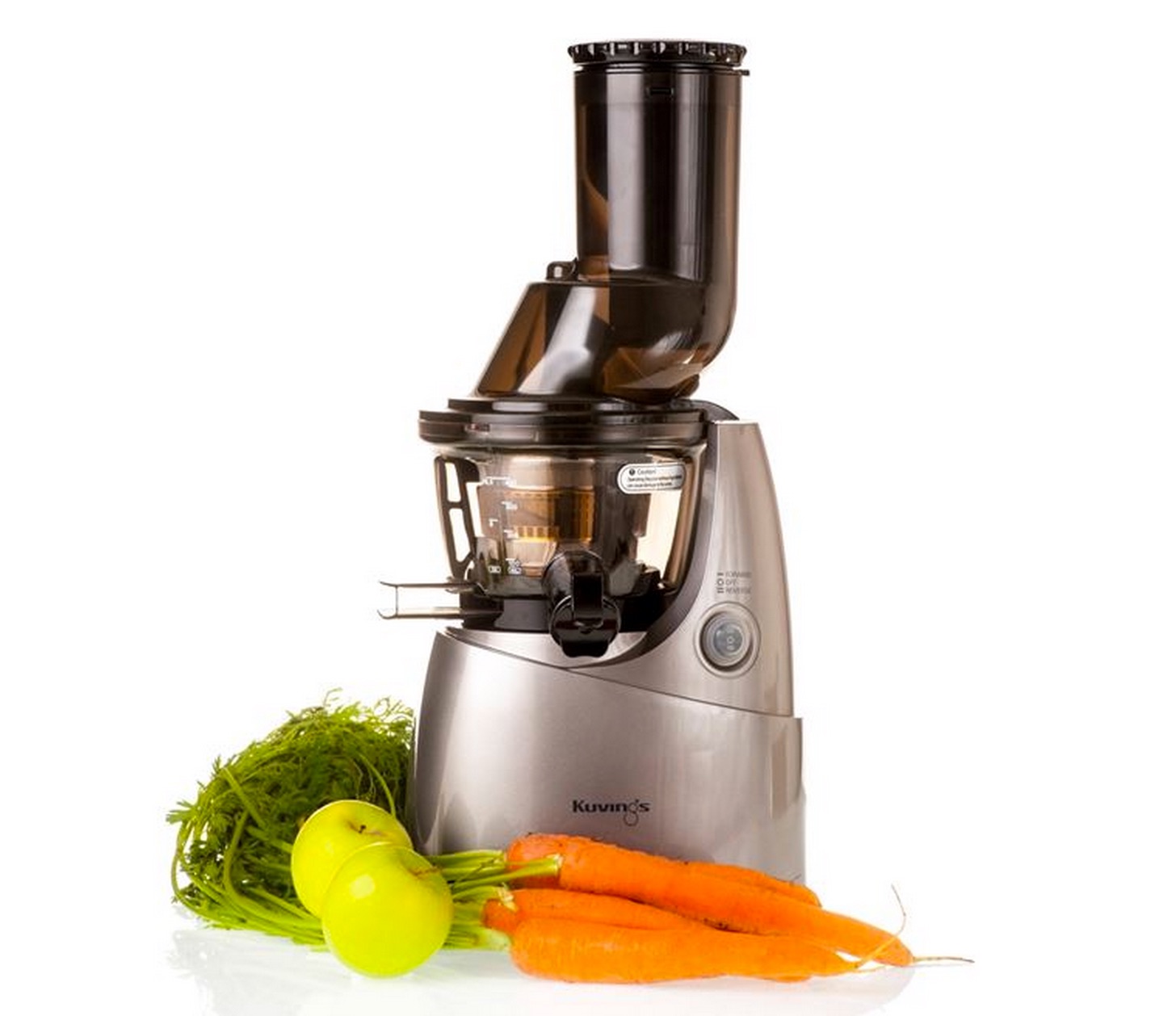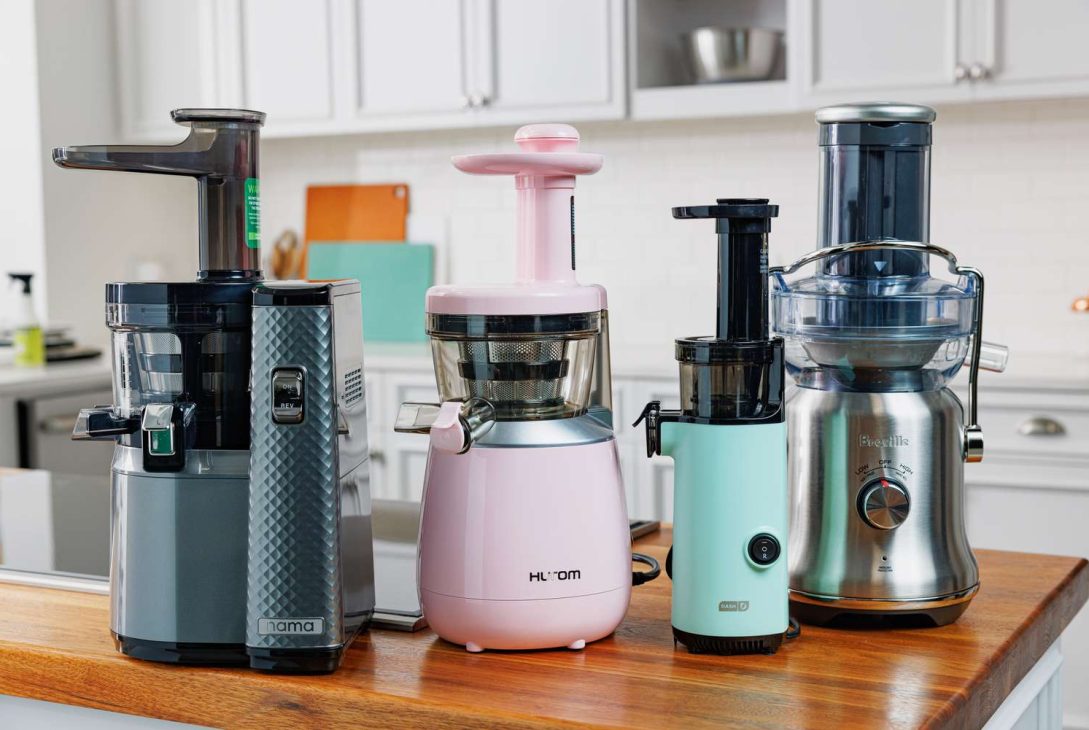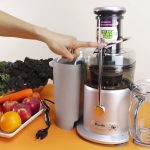A masticating juicer is a type of juicer that uses a slow and grinding motion to extract juice from fruits and vegetables without generating heat or foam. If you’re looking for a juicer that can efficiently extract juice while preserving the nutrients and enzymes in fruits and vegetables, then a masticating juicer is the perfect choice for you.
Unlike centrifugal juicers, which use high-speed spinning blades, masticating juicers work by slowly grinding and pressing the produce to extract the juice. This gentle process minimizes oxidation and heat generation, which can destroy the nutrients in the juice. Additionally, masticating juicers are highly efficient in extracting juice from leafy greens and wheatgrass, making them ideal for health-conscious individuals.
With their quiet operation and versatile functionality, masticating juicers are a popular option for those seeking a high-quality juicing experience.

Credit: www.ukjuicers.com
Understanding The Basics
A masticating juicer is a type of juicer that uses a slow, squeezing action to extract juice from fruits and vegetables. It operates at a low speed to preserve nutrients and enzymes, resulting in healthier and tastier juices.
Definition Of A Masticating Juicer
A masticating juicer is a type of juicer that operates by gently chewing and grinding fruits and vegetables to extract their juice. Also known as slow juicers or cold press juicers, these machines use a slow and methodical process to ensure maximum nutrient retention and juice extraction.
Unlike centrifugal juicers that use high-speed spinning blades, masticating juicers work at a slower pace, resulting in less oxidation and heat production, which can degrade the quality of the juice.
How A Masticating Juicer Works
- Auger and mesh screen: Masticating juicers feature a rotating auger that crushes and squeezes the produce against a mesh screen. This process breaks down the cell walls of fruits and vegetables, releasing their juice.
- Slow speed: Masticating juicers operate at a slow speed, typically ranging from 40 to 80 rpm (rotations per minute). This slow speed helps to preserve the nutritional value of the juice by reducing heat and oxidation.
- Cold press extraction: As the auger presses the produce against the mesh screen, the juice is extracted, while the pulp and fiber are separated. This process is often referred to as cold press extraction, as it minimizes heat and air exposure, resulting in juice that maintains its original flavor, color, and nutrients.
Key Features And Benefits Of Masticating Juicers
- High juice yield: Masticating juicers are known for their efficiency in extracting juice, producing a higher yield compared to other juicer types. The slow and thorough extraction method ensures that every drop of juice is squeezed out, leaving behind dry pulp.
- Nutrient-rich juice: The slow, gentle action of masticating juicers helps retain vital nutrients, vitamins, and enzymes that can be compromised by the heat and friction created by other juicer types. As a result, the juice extracted from masticating juicers is often considered to be more nutritious and beneficial for your health.
- Versatility: Masticating juicers are not limited to just fruits and vegetables. They can also handle leafy greens, wheatgrass, and herbs, allowing you to create a wider variety of juices and even experiment with nut milks, sorbets, and baby food.
- Quiet operation: Due to their slow speed and gentle extraction process, masticating juicers tend to operate quietly, making them suitable for early mornings or apartment living.
- Longer shelf life: The low oxidation and minimal heat produced by masticating juicers slow down the degradation process, resulting in juice that stays fresher for longer. This means you can prepare a batch of juice in advance without worrying about it spoiling too quickly.
Masticating juicers offer a unique set of features and benefits that make them a popular choice among health-conscious individuals. From their slow and effective extraction process to the increased nutritional value of the juice produced, masticating juicers provide a convenient way to enjoy fresh, nutrient-rich juices.
Whether you’re looking to kickstart a healthier lifestyle or simply enhance your daily intake of fruits and vegetables, a masticating juicer can be an excellent addition to your kitchen.
Types Of Masticating Juicers
Masticating juicers, also known as slow juicers, are a type of juicer that use a slow and gentle squeezing action to extract juice from fruits and vegetables. This method preserves more nutrients and enzymes, resulting in higher quality juice.
Masticating juicers are renowned for their ability to extract juice from fruits and vegetables efficiently while preserving the nutrients. There are three main types of masticating juicers: single auger, twin gear, and vertical juicers. Let’s delve into each type to understand their characteristics and benefits:
Single Auger Masticating Juicers:
- Single auger masticating juicers feature a horizontal design with a single gear that rotates against a screen.
- These juicers work by crushing and squeezing the produce, extracting juice with minimal oxidation and heat buildup.
- The slow juicing process ensures higher juice yield, extracting more juice from the same amount of produce.
- Single auger juicers are versatile and can handle a wide range of fruits, vegetables, leafy greens, and even wheatgrass.
- They are usually quieter than other juicer types and have a compact size, making them a great choice for households with limited space.
- Some single auger juicers also come with additional attachments for making nut butter, baby food, sorbets, and more.
Twin Gear Masticating Juicers:
- Twin gear masticating juicers, also known as triturating juicers, are designed with two gears that rotate inwards to crush and grind the produce.
- These juicers offer the highest juice yield and ensure maximum nutrient retention, making them popular among health enthusiasts.
- The twin gear system effectively breaks down the cell walls of fruits and vegetables, extracting juice with minimal oxidation.
- Twin gear juicers are particularly efficient in extracting juice from fibrous and hard ingredients like ginger, celery, and apples.
- However, they tend to be larger and heavier than other juicer types, occupying more space in the kitchen.
- These juicers are ideal for those who are serious about juicing and want to extract every bit of nutrition from their produce.
Vertical Masticating Juicers:
- Vertical masticating juicers combine the best features of both single auger and twin gear juicers.
- With a vertical design, these juicers take up less counter space while providing the benefits of masticating juicing.
- They typically have a wide feeding chute, allowing for easy insertion of whole fruits and vegetables, reducing prep time.
- Vertical juicers use an upright auger that efficiently crushes and squeezes the produce to extract juice.
- These juicers are versatile and can handle a variety of ingredients, including leafy greens, nuts, and even frozen fruits for sorbets.
- Cleaning vertical masticating juicers is often hassle-free due to their user-friendly design.
Now that you have a better understanding of the different types of masticating juicers, you can choose the one that suits your juicing needs and preferences. Whether you opt for the single auger, twin gear, or vertical juicer, you can enjoy nutrient-rich and flavorful juices that contribute to a healthy lifestyle.
Pros And Cons Of Masticating Juicers
A masticating juicer is a type of juicer that uses a slow squeezing method to extract juice from fruits and vegetables. It has many pros, such as producing high-quality juice and preserving nutrients, but it also has cons, including being more expensive and slower than other juicer types.
Pros Of Using A Masticating Juicer
- Higher juice yield: Masticating juicers use a slow and thorough process to extract juice, resulting in a higher yield of juice compared to other types of juicers. This means that you can get more juice out of your fruits and vegetables, maximizing your ingredients and reducing waste.
- Retains nutrients and enzymes: The slow and gentle juicing process of a masticating juicer helps to preserve the nutrients and enzymes in your fruits and vegetables. This means that the juice you get is not only delicious, but also packed with essential vitamins, minerals, and enzymes that are beneficial for your health.
- Versatile for various ingredients: Masticating juicers are great for juicing a wide variety of ingredients, including leafy greens, hard vegetables, and even nuts and seeds. This versatility allows you to experiment with different flavors and create a range of delicious and nutritious juices.
Cons Of Using A Masticating Juicer
- Slower juicing process: One downside of masticating juicers is that they have a slower juicing process compared to other types of juicers. The slow speed helps to retain nutrients, but it also means that it takes longer to make a glass of juice. If you’re in a rush or need to juice large quantities at once, a masticating juicer may not be the best choice.
- Higher price point: Masticating juicers tend to be more expensive than other juicers on the market. This is because they use advanced technology and offer the benefits of higher juice yield and nutrient retention. While the initial cost may be higher, the long-term savings from reduced ingredient waste and better quality juice can offset the price difference.
- Requires more preparation time: Masticating juicers typically require more preparation time compared to other juicers. This is because they have smaller feeding chutes, which means that you need to cut your fruits and vegetables into smaller pieces before juicing. While this extra step may seem time-consuming, it ensures that the juicer can effectively extract juice from a wide range of ingredients.
Choosing The Right Masticating Juicer
A masticating juicer is a type of juicer that uses a slow, squeezing motion to extract juice from fruits and vegetables. It is a healthier option as it retains more nutrients and enzymes compared to other juicers.
Masticating juicers are a popular choice among health-conscious individuals looking to incorporate fresh, nutrient-dense juices into their diets. These juicers use a slow, grinding mechanism to extract juice from fruits and vegetables, resulting in a higher yield and better preservation of vitamins and enzymes compared to centrifugal juicers.
If you’re considering purchasing a masticating juicer, it’s essential to choose the right one that meets your needs. In this section, we’ll explore the factors to consider when purchasing a masticating juicer, as well as some popular brands and models.
Factors To Consider When Purchasing A Masticating Juicer:
Budget:
- Determine your budget range before you start shopping for a masticating juicer.
- Prices can vary significantly, with some models costing several hundred dollars.
- Consider how frequently you’ll use the juicer and how important juicing is to your lifestyle when setting your budget.
Noise level:
- Masticating juicers operate at a much lower speed than centrifugal juicers, resulting in a quieter operation.
- However, some juicers may still produce noise, especially if they have a powerful motor.
- Look for juicers with noise reduction features if noise is a concern for you.
Ease of cleaning:
- Cleaning a juicer can be a time-consuming task, so consider the ease of cleaning when making your purchase.
- Some juicers have dishwasher-safe parts or offer removable components that are easy to clean by hand.
- Look for juicers with fewer parts and smooth surfaces to make the cleaning process more convenient.
Warranty:
- Masticating juicers can be a significant investment, so it’s important to consider the warranty offered by the manufacturer.
- A longer warranty period indicates the manufacturer’s confidence in the quality and durability of their product.
- Check the warranty coverage for both the motor and the other components of the juicer.
Popular Masticating Juicer Brands And Models:
Omega nc900hdc:
- The omega nc900hdc is a highly regarded masticating juicer known for its versatility and efficiency.
- It has a powerful motor and can effectively juice a variety of fruits, vegetables, and even leafy greens.
- With its durable construction and ease of use, this juicer is an excellent choice for juicing enthusiasts.
Tribest slowstar sw-2000:
- The tribest slowstar sw-2000 is another top-rated masticating juicer that offers exceptional performance.
- This juicer features a unique dual-blade auger design that ensures maximum juicing efficiency.
- It also operates at a slow speed, resulting in minimal oxidation and better juice quality.
Hurom h-aa slow juicer:
- The hurom h-aa slow juicer is known for its sleek design and excellent juice extraction capabilities.
- It uses an advanced slow squeezing technology to produce nutrient-rich juices with minimal pulp.
- This juicer is also equipped with a control lever that allows you to adjust the amount of pulp in your juice.
When choosing a masticating juicer, consider factors such as your budget, the noise level, ease of cleaning, and the warranty offered. Additionally, popular brands and models like the omega nc900hdc, tribest slowstar sw-2000, and hurom h-aa slow juicer are highly recommended for their performance and durability.
Take the time to research and compare different options before making your final decision. Happy juicing!
Tips For Using And Maintaining A Masticating Juicer
A masticating juicer is a type of juicer that slowly grinds fruits and vegetables to extract juice. These juicers are known for their high nutritional yield and are great for juicing leafy greens. To use and maintain a masticating juicer effectively, clean it thoroughly after each use, avoid overloading the feed chute, and follow the manufacturer’s instructions for proper assembly and disassembly.
Regular maintenance will ensure the longevity and performance of your masticating juicer.
If you’re a proud owner of a masticating juicer, you know the joy of creating fresh and nutrient-packed juices right at home. To keep your juicer performing at its best and extend its lifespan, here are some valuable tips to follow:
Preparing Fruits And Vegetables For Juicing:
- Wash and clean your produce thoroughly before juicing to ensure there are no traces of dirt or pesticides.
- Remove any hard pits, seeds, or stems from fruits and vegetables for better juicing efficiency.
- Cut larger fruits and vegetables into smaller pieces that can easily fit into the juicer’s feed chute.
Proper Juicing Techniques:
- Start with softer fruits and vegetables before moving on to the harder ones. This allows for more efficient juicing and prevents clogging.
- Feed the produce slowly into the juicer to prevent overloading and improve juice extraction.
- Alternate between different types of produce to create a well-balanced and flavorful juice.
- Avoid excessive force when pushing down the produce, as it may strain the juicer’s motor and affect its performance.
Cleaning And Maintenance Tips To Prolong The Juicer’S Lifespan:
- Always refer to the manufacturer’s instructions for cleaning your specific juicer model.
- Immediately after juicing, disassemble the juicer and rinse all the removable parts with warm water to remove any residual juice and pulp.
- Use a soft brush or sponge to gently scrub away any remaining pulp. Avoid using abrasive materials that could damage the juicer’s components.
- Allow the parts to air-dry completely before reassembling the juicer.
- Regularly inspect and clean the juicer’s filter and strainer to prevent clogging and ensure optimal juice extraction.
- Lubricate any moving parts as recommended by the manufacturer to maintain smooth operation.
- Store your juicer in a clean, dry place, away from moisture and extreme temperatures.
By following these simple tips for using and maintaining your masticating juicer, you can continue enjoying delicious and healthy juices while keeping your juicer in excellent condition for years to come. Happy juicing!
Recipes And Tips For Masticating Juicers
Discover a collection of delicious recipes and helpful tips specifically tailored for masticating juicers. Uncover the wonders of this innovative juicing method and elevate your juicing experience.
If you’re new to masticating juicers or simply looking for some fresh ideas, we’ve got you covered. Check out these mouthwatering recipes and practical tips to make the most out of your masticating juicer!
Green Juice Recipes:
- Kale and pineapple delight: Blend a handful of kale, a cup of fresh pineapple chunks, half a cucumber, and a squeeze of lemon for a refreshing and nutrient-packed green juice.
- Spinach and apple fusion: Combine a bunch of spinach leaves, two green apples, a small piece of ginger, and a sprig of mint for a zesty and invigorating green juice.
- Cucumber and mint elixir: Process three cucumbers, a handful of fresh mint leaves, a teaspoon of spirulina powder, and a dash of lime juice for a hydrating and detoxifying green juice.
Nut Milk Recipes:
- Creamy almond milk: Soak a cup of almonds overnight, then blend them with three cups of water. Strain the mixture using a nut milk bag and add a touch of vanilla extract or a date for a naturally sweet and creamy almond milk.
- Cashew and coconut dream: Combine a cup of cashews, two cups of coconut water, a tablespoon of coconut oil, and a pinch of sea salt. Blend until smooth, strain, and enjoy a rich and luscious cashew-coconut milk.
- Hazelnut and cacao indulgence: Soak a cup of hazelnuts, blend them with three cups of water, and strain. Add two tablespoons of cacao powder and a tablespoon of maple syrup for an indulgent and dairy-free treat.
Sorbet And Dessert Recipes:
- Mixed berry sorbet: Blend two cups of assorted berries (strawberries, blueberries, and raspberries) with a tablespoon of maple syrup and a squeeze of lemon juice. Freeze the mixture in a shallow dish for a few hours, then blend again for a refreshing and guilt-free sorbet.
- Creamy avocado lime pudding: Blend two ripe avocados, the juice of two limes, a tablespoon of honey or agave nectar, and a pinch of sea salt until smooth. Chill in the refrigerator for a couple of hours and savor a velvety and tangy avocado lime pudding.
- Chocolate-banana nice cream: Freeze three peeled and sliced bananas, then blend them with two tablespoons of cocoa powder, a tablespoon of almond butter, and a splash of almond milk. Enjoy a decadent and healthy chocolate ice cream alternative.
Whether you’re craving a vibrant green juice, a creamy nut milk, or a delightful sorbet, these recipes for masticating juicers will satisfy your taste buds and nourish your body. So get your juicer ready and indulge in the goodness of fresh and wholesome ingredients.
Cheers to a healthy and flavorful journey!
Frequently Asked Questions
A masticating juicer is a type of juicer that uses a slow, grinding process to extract juice from fruits and vegetables. It preserves more nutrients and enzymes, resulting in a healthier and more flavorful juice.
Are Masticating Juicers Better Than Centrifugal Juicers?
Masticating juicers and centrifugal juicers both have their unique features and benefits. Here is a comparison between the two:
- Masticating juicers:
- Slow and gentle juicing process
- Efficient at extracting juice from various fruits and vegetables
- Can handle leafy greens with ease
- Retains more nutrients, enzymes, and antioxidants in the juice
- Produces less foam and oxidation
- Operates quietly
- Can be used to make baby food, nut butter, and sorbets
- Centrifugal juicers:
- Fast juicing process
- Suitable for juicing hard fruits and vegetables
- Less expensive than masticating juicers
- Requires less preparation time due to larger feeding tubes
- May produce more foam and oxidation, resulting in a shorter shelf life for the juice
- Can be noisier during operation
Ultimately, choosing between masticating and centrifugal juicers depends on your specific needs and preferences. If you prioritize nutrient retention, quiet operation, and versatility, a masticating juicer may be a better option for you. However, if speed, convenience, and affordability are your priorities, a centrifugal juicer might be more suitable.
Can Masticating Juicers Juice Leafy Greens?
Yes, masticating juicers are excellent for juicing leafy greens. Unlike centrifugal juicers that may struggle with leafy greens, masticating juicers are designed to handle fibrous and delicate greens, such as kale, spinach, and wheatgrass. Through their slow and thorough juicing process, masticating juicers effectively extract the maximum amount of juice from leafy greens, ensuring you get the most nutrients from these ingredients.
So, if juicing leafy greens is an essential part of your juicing routine, a masticating juicer is highly recommended.
How Long Does Juice From A Masticating Juicer Last?
Due to the slow juicing process and minimal oxidation, juice made with a masticating juicer has a longer shelf life compared to juice made with a centrifugal juicer. Typically, juice from a masticating juicer can last for up to 72 hours when stored properly in airtight containers and refrigerated at a temperature below 40°f (4°c).
It is important to note that the exact shelf life may vary depending on the specific ingredients used and the quality of the juicer. To maximize the freshness and nutrient content of your juice, it is advisable to consume it as soon as possible after juicing.
Conclusion (Do Not Use)
A masticating juicer is a type of juicer that uses a slow grinding and crushing action to extract juice from fruits and vegetables. This method helps to preserve more nutrients and enzymes in the juice, making it a healthier option for juicing enthusiasts.
Masticating juicers have gained popularity in recent years due to their ability to preserve nutrients and produce high-quality juice. If you’re still on the fence about trying out a masticating juicer, let’s recap some of the benefits that this type of juicer offers:
Recap Of The Benefits Of Masticating Juicers:
- Slow and gentle juicing process: Masticating juicers use a slow and deliberate process to extract juice from fruits and vegetables. This slow squeezing action helps to retain more nutrients, enzymes, and vitamins compared to other juicers.
- High juice yield: Masticating juicers are known for their high juice yield. The juicing process effectively breaks down the fibers in fruits and vegetables, allowing you to extract a greater amount of juice. This means you can get more juice from the same amount of produce, saving you money in the long run.
- Versatility: Masticating juicers are not just limited to juicing fruits and vegetables. Many models come with additional attachments that allow you to make nut butters, baby food, sorbets, and even pasta. This versatility makes a masticating juicer a valuable addition to your kitchen.
- Longer shelf life: The slow juicing process of masticating juicers helps to minimize oxidation, which leads to longer shelf life for your juice. This means you can make larger batches and store them for longer periods without compromising on quality.
- Quiet operation: Unlike centrifugal juicers that can be noisy, masticating juicers operate quietly. This makes it a great choice if you prefer a peaceful juicing experience, especially in the early mornings or late evenings.
Encouragement To Try Out A Masticating Juicer For A Healthier Lifestyle:
If you’re looking to adopt a healthier lifestyle, introducing a masticating juicer into your routine could be a game-changer. Not only will you enjoy the nutritional benefits of fresh juice, but you’ll also have the opportunity to experiment with different fruit and vegetable combinations to create delicious and nutritious blends.
By investing in a masticating juicer, you can:
- Enhance your nutrient intake: Masticating juicers preserve more nutrients than other juicers, giving you a concentrated dose of vitamins, minerals, and enzymes in every glass of juice.
- Boost your immune system: Freshly extracted juices are packed with antioxidants that help strengthen your immune system and promote overall well-being.
- Increase your energy levels: Nutrient-rich juices provide a quick and natural energy boost, making them a healthier alternative to sugary beverages or caffeine.
- Support your digestion: The fiber content in fruit and vegetable juices can aid digestion, promoting regular bowel movements and a healthy gut.
So why wait? Take the leap and try out a masticating juicer today. Your body will thank you for it as you embark on a journey towards a healthier lifestyle.
Frequently Asked Questions For What Is A Masticating Juicer
What Is The Difference Between A Masticating Juicer And A Regular Juicer?
A masticating juicer and a regular juicer differ in their functioning and the quality of juice they produce. A masticating juicer, also known as a slow juicer, uses a slow grinding and pressing action to extract juice. This gentle process preserves more nutrients, enzymes, and vitamins in the juice.
On the other hand, a regular juicer, or centrifugal juicer, uses high-speed spinning blades to separate juice from the pulp. While this method is faster, it generates heat and can introduce more oxygen into the juice, leading to some nutrient loss.
The juice from a masticating juicer tends to have a longer shelf life and can be stored for up to 72 hours, while juice from a regular juicer is best consumed immediately. Additionally, masticating juicers are better at handling leafy greens and herbs, while regular juicers are more efficient with fruits and vegetables.
Is A Masticating Juicer Really Better?
Yes, a masticating juicer is indeed better. It operates at a slower speed, which helps retain more nutrients and enzymes from fruits and vegetables. The gentle grinding action of a masticating juicer also produces less heat, preventing oxidation and maintaining the freshness and flavor of the juice for longer periods.
Additionally, the slower juicing process yields a higher juice yield, extracting more juice from the produce. This makes masticating juicers more efficient and cost-effective in the long run. The juicer’s ability to handle a wider variety of ingredients, including leafy greens and wheatgrass, further sets it apart from centrifugal juicers.
Moreover, masticating juicers operate quietly, making them suitable for any environment. With these advantages, a masticating juicer is the better choice for those seeking maximum nutrition and quality in their juices.
What Is Better Masticating Or Cold Press Juicer?
Masticating and cold press juicers both offer health benefits, but their processes differ. Cold press juicers use a slow extraction method to produce juice with minimal heat and oxidation, retaining more nutrients. On the other hand, masticating juicers use an auger to crush fruits and vegetables, maximizing juice yield.
Both options have their advantages. Cold press juicers ensure that enzymes, vitamins, and minerals remain intact, while masticating juicers efficiently extract juice and produce less foam. The choice depends on personal preference and juicing goals. If preserving nutrient content is a priority, a cold press juicer is a better option.
However, if maximum juice extraction is desired, a masticating juicer may be more suitable. Ultimately, it’s important to choose a juicer that aligns with your specific needs and preferences.
What Are The Disadvantages Of A Masticating Juicer?
Masticating juicers have a few disadvantages. First, they are more expensive than centrifugal juicers. Second, they have a slower juicing process, which can be time-consuming. Third, they require more effort to clean due to their complex parts. Fourth, they have a smaller feeding chute, which means more time spent on pre-cutting ingredients.
Fifth, they are less effective at juicing soft fruits and leafy greens compared to centrifugal juicers. Finally, masticating juicers produce a pulpier juice texture that some people may not prefer. Despite these drawbacks, masticating juicers offer benefits such as higher juice yield, better nutrient retention, and quieter operation, making them a popular choice for health enthusiasts.
Conclusion
To sum up, a masticating juicer is a valuable appliance that offers a range of benefits. Its slow and gentle extraction process ensures maximum nutrient retention and higher juice yield. With its versatility, it can handle a variety of produce, including fruits, vegetables, leafy greens, and even nuts.
The resulting juice is not only full of flavor, but also packed with essential vitamins, minerals, and enzymes. Moreover, masticating juicers produce less foam and oxidation, resulting in longer-lasting, healthier juices. Their quiet operation and easy cleanup make them convenient for daily use.
Investing in a masticating juicer can be a game changer for those looking to improve their overall health and well-being. By incorporating fresh and nutritious juices into their diet, individuals can enjoy a wide range of health benefits and experience a boost in energy levels.
So, why wait? Be proactive about your health and consider adding a masticating juicer to your kitchen arsenal today.

Freda is a passionate foodie and kitchen gadget enthusiast. With over 10 years of experience in the culinary industry, Freda brings her expertise in testing and reviewing kitchen gadgets.




